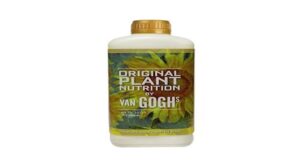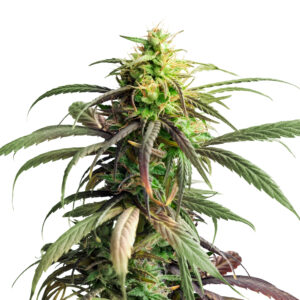 By:
Amos Mwaniki
By:
Amos Mwaniki
For your plant to grow properly, the soil must be fertile enough to support growth. Weed plants require different nutrients at different ratios during different stages of their life. Regardless of the strain, the macronutrients required by all plants include nitrogen, potassium, phosphorus, magnesium, calcium, and sulfur.

From the seedling to the vegetative and flowering stages, weed strains consistently draw essential nutrients from the soil. Depending on the health of the root and stem, these nutrients are absorbed through the microscopic pores in the root, stored, and translocated to other parts of the plants where they are needed. As expected, these nutrients help the plant through bud formation, leaf development, stem growth, and flowering. Without the proper supply of nutrients at the correct growth stage, the plant becomes stunted as the harvest yield significantly reduces. In extreme cases, the plant withers and dies.
For your plant to get the proper nutrients, the soil must be fertile enough to support growth. If you use a hydroponic system, the nutrients must be supplied in a form the plant can readily absorb. Compared to any other plant, supplying nutrients to a marijuana plant requires adequate planning. Sometimes, this involves selecting the right marijuana fertilizer and applying it at the right time. Your preferred marijuana fertilizer must have enough micronutrients and macronutrients to support growth. Regardless of the strain, the macronutrients required by all weed plants include nitrogen, potassium, phosphorus, magnesium, calcium, and sulfur. While other nutrients are also needed in large amounts, these three nutrients are designated as the principal macronutrients for marijuana. In addition, the micronutrients are required in smaller quantities, including Boron, Manganese, Copper, Iron, Molybdenum, cobalt, silicon, chlorine, and selenium.
Your plant depends much on its supply and deposit of nitrogen. This macronutrient is a building block of Chlorophyll, the green pigment needed for photosynthesis. If your plant lacks Nitrogen, the chlorophyll functions in photosynthesis are altered. Subsequently, the plant will find converting sunlight to carbon dioxide, water, oxygen, and glucose difficult. Without these essential plant resources, the plants starve and wither away. In addition to its role in glucose formation, Nitrogen is also needed at every stage of growth. It also serves as a central building block for plant amino acids. These acids are required to make plant protein. Weed plants use their store of protein to develop denser buds, stronger stems, and healthy leaves.
The importance of Nitrogen for a young weed plant cannot be overemphasized. Plants depend on it to make blocks of DNA and RNA. These genetic components determine the plant’s behavior and other characteristics, such as potency, flavor, taste, and odor. They are also needed for the plant tissues to multiply and grow during the vegetative stage. Although Nitrogen appears very important for marijuana, an excess supply of these nutrients is equally detrimental to average growth. So, it is recommended that you get your plant tested for Nitrogen first before deciding on the quantity to supply.
Phosphorus is another macronutrient you don’t want to miss out on. Like Nitrogen, phosphorus also plays a massive role in photosynthesis, ensuring the young cannabis plants get enough oxygen and glucose for their metabolism. Plants also need phosphorus for respiration, cell division, and nutrient storage. If your plant lacks phosphorus, the growth process is altered and withers out prematurely. Weak stems, stunted growth, bluish-green leaves, and poor flowering are the typical signs of phosphorus deficiency. Excess phosphorus also complicates the growth cycle. If supplied in excess, phosphorus makes the surrounding soil toxic, killing off essential microorganisms needed by the plant.
Cannabis plants use their potassium stores to regulate water and salt levels. This regulation balances the plant’s internal acidity and basicity levels. As with phosphorus and Nitrogen, potassium also plays a significant role in photosynthesis. Plants that lack potassium are likely to develop weak steam incapable of supporting healthy, large buds. The leaves become yellow, and the plants lose out big on photosynthesis. They become crispy, with burnt-looking edges, and fall off prematurely. If the pot plant shows all these signs, you must give it a potassium supplement. The readily available deposit of plant potassium includes kelp meal, hardwood ashes, and alfalfa meal.
We have established that weed needs nutrients to grow properly. If your growing medium or garden soil lacks these nutrients, you need to supply these nutrients to the plants externally. However, you can add nutrients to the soil based on intuition. Plants require different nutrients at different ratios during different stages of their life. To help you stay a step ahead, we have outlined the different stages of the marijuana growth cycle and how much nutrients are required for these stages;
At the seedling stage, marijuana gets the bulk of its nutrients from the seed. The tender offshoot absorbs water through the leaves as the roots rapidly develop. Your young marijuana seedlings must be protected from scorching heat and assembled in a warm, humid environment. If everything goes well and the seeds have enough nutrient deposit, the tender plant rapidly grows to develop leaves quickly. You won’t need to feed your plant until it is 3-4 weeks old. Once it develops about four true leaves, it transitions to vegetative.
At the vegetative stage, the nutrient deposit of the seed is exhausted, the toot system is developed, and the leaves’ stomata become more active. To meet the nutrient supply, the cannabis plant becomes an external nutrient depot. In many cases, this is usually the growth medium. This is when your plant desperately needs to be fed. We recommend you start with a light 2:1:2 (nitrogen: potassium: phosphorus) fertilizer. Initiate this regimen for one week. By doing this, you introduce the plants to their fertilizers and reduce the risk of nutrient burn. If your plants show signs of nutrient deficiency, you can start with the 4:2:3 fertilizer regimen.
Cell division and bud formation start as your plant transitions into the mid-vegetative phase (about six weeks after germination). Your plant rapidly uses its store of nutrients as they are expended in the growth process. This is the stage, you will want to increase the nutrients you supply rapidly. We recommended switching to the 10:5:7 fertilizer regimen at this point. Your plant should develop robust and healthy foliage, bright green leaves, and extensive root and string stems. The buds also start developing in readiness for flowering.
Towards the end of the vegetative phase, you will want to lower your nitrogen supply and prepare the plants for their bloom booster fertilizer regimen. Many experienced weed farmers use van Gogh’s Master Miracle C fertilizer bloom booster feed. To easily remember the fertilizer ratios, consider the chart below;
Nutrient Requirement for the Flowering Cannabis Plants
At flowering, the focus of the plant is directed on developing large, resinous flowers. At this stage, the plant needs less nitrogen, potassium, and phosphorus for cellular division. You should observe your plant for any signs of nutrient deficiency in the first week of flowering. This allows you to understand the modification required in the fertilizer ratio. We recommend the commonly used 5:7:10 fertilizer regimen. This ratio supplies less Nitrogen and more potassium. Therefore, the potassium concentration in all the fertilizer ratios is increased from this stage.
As the plant transitions into the mid-flowering stage, the cell formation rate increases as more flowers form. You will want to supply more potassium by introducing the mid-flowering fertilizer booster. This booster is recommended as a 6:10:15 nutrient ratio. As the last days of flowering approach, the plants produce fewer flowers as the plant features mature. This signals the readiness for harvest. Experienced marijuana farmers modify the nutrient ratio again at this stage. The 4:7:10 fertilizer is introduced to support growth into the pre-harvest stage. To make it easier, we have simplified the fertilizer ratio during this stage into a chat below;
You must understand how exactly to apply your fertilizers. Many fertilizer brands provide a feeding chat and instructions for application for every NPK formulation you purchase. These instructions offer guidance on how best to apply these fertilizers.
Your return on investment depends mainly on your yield. This yield, in turn, depends on how well you tender your plants. Fertilizer applications help your plant to store nutrients. Watch out for the fertilizer brands you select. A good fertilizer must be easy to apply, environmentally friendly, and constitute no health hazard to the farmer. It is also essential that the fertilizer does not negatively affect the taste, aroma, cannabinoid compositions, and terpene levels of the marijuana plant.













Related Posts

Like us, plants need nutrients to live. So do your weed plants. The crop requires nutrients to germinate, vegetate, flower, and fight off pests and diseases. We have several kinds of crucial nutrients that your weed crop needs. The nutrients are classified into macronutrients and micronutrients.

Cannabis leaves are the de facto symbol of weed, besides that they have an important role in the growth and overall development, they help promote the vital process of photosynthesis.

Growing marijuana requires more than just sticking a few cannabis seedlings into the soil and waiting for its buds. In addition to carefully tracking its growth, cannabis demands a lot of careful tendering.